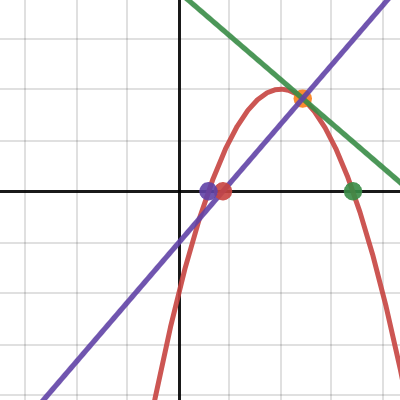Hey, the question is as follows:
To the curve y=2−(x−2)2 both a tangent and a normal is drawn from the same point. The tangent and the normal together shape a triangle with the area of 4.5 area units. Find the point of tangent.
I initially solved it by first expressing a function for both the tangent and the normal as follows:
yt−f(a)=f′(a)(x−a)yn−f(a)=−f′(a)1(x−a). Plugging in and simplifying I get that;
yt(x)=a2+4x−2ax−2yn(x)=2(a−2)8−21a+12a2−2a3+x
If I then find the point at which they intersect the x-axis and take the difference, I have got my base and the height is given by f(a). So a can then be given using area of a triangle.
yt=0⟹xt=2(a−2)a2−2yn=0⟹xn=−8+21a−12a2+2a3
The area is given by 2bh=2∣xt−xn∣f(a)=29⟺a1=1.73499,a2=2.26501a_1 does not yield a solution to the problem, so only a_2 is a valid value. From here it is easy to find the (x,y) coordinates and even the equation for the tangent and normal.
I was then also presented by a solution that used tan(x) and tan(90-x) due to the right angle formed at the top of the triangle (the point where the normal and tangent are drawn from).This piqued my interest, are there other methods/tricks to solving this problem?
To the curve y=2−(x−2)2 both a tangent and a normal is drawn from the same point. The tangent and the normal together shape a triangle with the area of 4.5 area units. Find the point of tangent.
I initially solved it by first expressing a function for both the tangent and the normal as follows:
yt−f(a)=f′(a)(x−a)yn−f(a)=−f′(a)1(x−a). Plugging in and simplifying I get that;
yt(x)=a2+4x−2ax−2yn(x)=2(a−2)8−21a+12a2−2a3+x
If I then find the point at which they intersect the x-axis and take the difference, I have got my base and the height is given by f(a). So a can then be given using area of a triangle.
yt=0⟹xt=2(a−2)a2−2yn=0⟹xn=−8+21a−12a2+2a3
The area is given by 2bh=2∣xt−xn∣f(a)=29⟺a1=1.73499,a2=2.26501a_1 does not yield a solution to the problem, so only a_2 is a valid value. From here it is easy to find the (x,y) coordinates and even the equation for the tangent and normal.
I was then also presented by a solution that used tan(x) and tan(90-x) due to the right angle formed at the top of the triangle (the point where the normal and tangent are drawn from).This piqued my interest, are there other methods/tricks to solving this problem?

